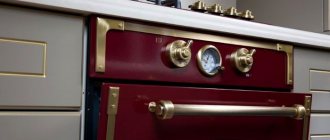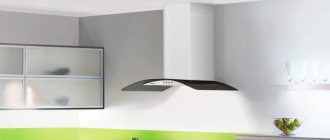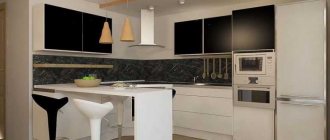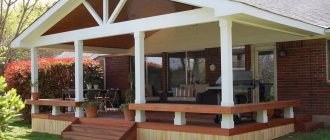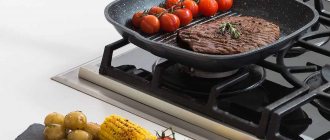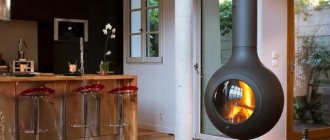What is convection
Convection is the movement of heat by air currents inside the oven. During the process, cold and warm air masses are exchanged and mixed, as a result of which the temperature inside the furnace becomes the same and uniform throughout the entire volume of the enclosed space.
Depending on the mechanism of action, it is customary to distinguish between natural (free) convection, when air flows mix naturally. In this case it happens quite slowly. There is also forced convection, the principle of which is incorporated in modern ovens; this is a mode of forced circulation of warm air in the space, which is carried out thanks to special fans.
Why is convection needed?
It is difficult to overestimate the advantages of the convection mechanism in an electric oven or other device. This technology is provided in most modern household ovens. First of all, it is indispensable when baking large pieces of meat, pies, making pizza, grilled chicken or toast.
Convection promotes uniform cooking of the dish, with its help you can avoid burning in one part of the dish and inadequate baking in another. Previously, to do this, you had to constantly turn the sheet over and change the position of the dish on it. The technology allows you to cook large pieces of fish or whole meat. In addition, convection adds a number of advantages:
- rapid warming up of cold air, accordingly, saving time to obtain the desired temperature;
- the appearance of a crispy crust, the ability to dry out an overly juicy dish;
- possibility of simultaneous preparation of several dishes;
- in the presence of moist convection, food is partially steamed, retaining more beneficial properties and minerals.
How to tell if your oven has convection
If, when purchasing an oven, you did not inquire about the presence of such an important technology in it, then special signs on the control panel will help you understand this issue. On different models and on different convection type options, they may differ, but most often they are presented in the form of a fan icon, as well as indicators of its operating modes.
Principle of operation
The operating principle of convection is based on an active heat exchange process, which is achieved using a powerful fan located on the rear wall of the heating chamber. It accelerates the movement of air flows, thereby facilitating rapid heating of the oven volume.
Do you need convection in an electric oven?
Although modern models are mostly presented with a convection function, it is not difficult to find a model on the market without it. When purchasing, everyone must decide for themselves whether the convection function is needed or not.
There are some users who, even having bought an electric oven with this function, used it only a few times. If the equipment is purchased with a specific desire to please your family and loved ones every day with a variety of dishes and baked goods, then this function is of course desirable. When purchasing, additionally find out all the details of a specific model with convection from the seller, so that later you do not have to be disappointed in the product.
Usefulness of convection
Convection in the oven will make cooking as fast, easy and enjoyable as possible. From now on, you won’t have to worry about baked goods that are burnt or not baked inside. It doesn't matter whether you're cooking meat, vegetables, or working with dough, the results will be excellent. The dish will be baked equally on all sides: inside, along the edges, top and bottom.
So, what is convection in an oven, how does this system work? The main thing in the oven has always been considered high-quality heating. Many people know that in order to avoid burning of baked goods, the baking sheet must be moved higher or swapped if the housewife decided to cook on two at once. The convection mode will eliminate unnecessary steps and ensure uniform cooking of any dish. From now on, your baked goods will not burn on the bottom, will be baked inside, and will be perfectly browned on top.
Literally, convection is translated as transfer. In this case, we are talking about the unhindered transfer of air inside the oven using a specially installed fan. It is this device that performs the important function of moving flows of cold and warm air, guaranteeing the same temperature in different parts of the cabinet.
The oven fan is usually installed on the back wall. After reaching a certain temperature, it stops automatically. The current convection oven has a huge number of different modes that allow you to bake, fry, and defrost food. Many models combine convection with other functions, such as a grill.
The furnace may have mechanical, electromechanical or electronic control. Each mode is indicated on the panel by a corresponding icon. Sometimes there are a lot of such icons, so to understand their meaning, you need to refer to the instructions included with the product. The mode we are interested in has a generally accepted designation, which is the same for all models of this equipment. If you are interested in an oven with a convection function in the oven, look for the fan icon. This is how today a stove equipped with such a useful option will be designated.
It is well known that warm air is lighter than cold air, so it rises. This process will continue until the temperature in all corners of the oven is equalized. This heat exchange is called natural convection. Of course, these phenomena occur in all ovens, regardless of the number of burners. It would seem, why overpay for an additional built-in fan? However, the natural movement of air is so slow that there is simply not enough time to get a good result.
In order to somehow speed up the movement of air, manufacturers began to install fans in the oven. This device accelerates the heat exchange process, which means the air moves faster, equalizing the temperature at all points of the furnace. Cooking meat, fish, baking biscuits or casseroles in kitchen appliances with forced convection will be much faster, and the result will certainly please the hostess.
Free and forced convection
The movement of warm air masses itself, as noted above, is convection. But depending on what prompts them to circulate and mix, it is customary to distinguish between free (natural) and forced convection. Free convection occurs on its own in many processes, and occurs without external influence. Hot air becomes lighter, causing it to rise upward. Cold, being heavier – down. The efficiency and speed of such natural convection is much lower than that of forced or forced convection.
In the case of forced convection, air masses, under the influence of, for example, a special fan, circulate and mix much faster and more efficiently. As a result, hot air flows are fairly quickly distributed evenly in a confined space.
Types of convectors
Since the appearance of the first ovens with convection function, various types and modifications of this technology have appeared. And today there are many types of them:
- A fan is the simplest type of convection. The bottom line is that when the fan blades operate, the air inside begins to actively move and mix, resulting in uniform baking of dishes.
- Fan with ring heater. This is already a more efficient system. In this case, the fan has an additional heating element, as a result of which warm air flows fill the space much faster.
- Reinforced convector. The meaning lies in the name itself. Essentially, this is the same fan, but much more powerful. With such a system, the air warms up much faster and more intensely. The food in the oven quickly becomes covered with a thin, pleasant crust on top.
- Moist convection. In this case, a steam generator is also built into the oven, due to which the air inside is actively saturated with steam. This is stewing, not frying. At the same time, the dishes turn out juicy, they retain more nutrients.
- Double convection. With this type of convection, which is also installed on some oven models, two fans are located opposite each other, each of which forces air masses to circulate at its own level. This type is most convenient when preparing several dishes at the same time.
Each of these convectors has its own advantages. For example, reinforced ones are best suited for roasting meat. Before purchasing a specific model, you should ask the seller what kind of convection system is installed in the selected model.
Devices with convection function
Gas convection oven
Gas stoves with built-in convection ovens are popular with many practical housewives. This is primarily due to the relatively low cost of fuel. Externally, such a stove is practically indistinguishable from an ordinary modern gas stove. However, a special fan is built into the back wall of such devices.
The convector in such a stove has a number of operating features. Since in these models the heating part is located at the bottom, before putting the dish in the oven for cooking, you must first turn on the convector for a short period, and then send the dish into the oven for cooking.
The disadvantages of this type include the lack of complete sealing of the oven, since it is necessary that combustion products have a constant outlet. This ultimately leads to longer cooking times.
Electric convection oven
Some housewives wonder how necessary convection is in the oven, because it itself is a fairly powerful fryer, capable of heating up to a temperature of several hundred degrees. In fact, even such a powerful flow of warm air is not capable of ensuring ideal uniformity of its distribution, and, accordingly, uniform cooking of the dish.
Today, voluntarily abandoning the convector in the oven is not a reasonable decision. It is thanks to him that it is possible to achieve ideal uniform baking of the dish, juiciness and crispy crust on the surface. It’s no wonder that models of electric stoves with convection are the most popular among buyers today.
Grill with convection
The grill function quite often comes as part of the options of modern stoves. The grill allows you to easily and efficiently cook meat on a spit. There are two types of grill:
- Gas. In this case, there is a high-quality imitation of cooking over coals.
- Electric. Its feature is more convenient operation.
Grill and convection combine perfectly and complement each other. There are two types of grills: air grill and turbo grill. The desired mode is very simply activated by pressing the corresponding button on the control panel. The advantage of using an air fryer is the ability to obtain high-quality roasted meat with a crust.
What is convection in a microwave oven
For a long time now, the microwave oven has become an integral part of the kitchen equipment set of most families. It allows you to quickly heat up various foods and semi-finished products, and defrost foods. Microwave ovens today also use convection quite often.
Moreover, in essence it does not differ from that in a standard oven, except for the size. The fan distributes air flow inside the chamber. When a certain temperature is reached, the system automatically turns off. The use of convection in microwave ovens can significantly reduce the time of defrosting and cooking food.
Operating principle of a convection oven
Previously, owners of electric stoves were jealous of those who had gas ones. Gas-powered appliances were cheaper to operate. But this was not the main thing, but the fact that the gas oven warmed up faster and baked dishes much better than an electric one. Although, there were some nuances here too.
In Soviet models of gas and electric ovens, heating elements (heating elements or burners) were located only in the lower part of the chamber. Of course, when heated, the hot air rose upward, but this happened unevenly. The baking sheets interfered with the natural circulation of air flow. As a result, the dish was heated well from below and even had time to burn, while on top it was barely baked. And if the housewife wanted to save time and cook on two baking sheets at once, she had to constantly be on duty near the oven to swap them and turn them. Convection technology can greatly simplify the cooking process, but nothing was known about it at the time.
But the housewives still tried to solve the problem in various ways. Looking into the oven, one could find several unusual objects - bricks, containers with sand and water. Thus, attempts were made to achieve more even heating and prevent food from burning. And I must say, these methods worked, although not without fail.
The convection function made it possible to permanently abandon these additional devices. To ensure even heating, ovens began to be equipped with built-in fans. The principle of convection consists in the forced movement of heated air masses throughout the entire volume of the inner chamber.
Knowing how convection works in an oven, you can easily determine the main advantage of this function - uniform baking of dishes regardless of their location in the chamber. You can install not one, but two, or even three baking sheets in the oven - everything will be cooked perfectly, and with virtually no intervention from you. There is no need to rearrange or rotate sheets.
Convection technology has many advantages. It was thanks to her that ovens “learned” to defrost food and speed up the rise of yeast dough. By combining the operation of a convector and other heating elements (heating elements, burners, grill), you can use different cooking methods. A convection oven will be one of the most successful purchases for your kitchen.
Gas convection ovens
The convection gas oven became a real test for designers. Installing a built-in fan in the chamber is not difficult, but there is one “but”: the air flow from the convector blows out the burner flame. This is dangerous as it can cause a gas leak. In addition, a gas oven cannot be sealed, since combustion products must be vented outside. This provokes heat loss, due to which the cooking process will take longer.
Meanwhile, it is in a gas oven that convection is very necessary. Unlike electric models, in which heating elements are now installed both at the top and at the bottom, gas-powered devices are equipped with only one burner, so the heating in the chamber will be uneven in any case. A convector could eliminate this problem. Therefore, the design of gas convection ovens had to be complicated, which affected their cost.
It's no surprise that a convection gas oven is a rarity. Manufacturers who produce such models can be counted on the fingers of one hand. The devices are necessarily equipped with a gas control system, which will shut off the fuel supply if the burner suddenly goes out. More advanced models can be equipped with an automatic electric ignition system, which is activated when the flame extinguishes. If the burner cannot be re-ignited, the gas supply is cut off. In addition, manufacturers are improving the design of ovens so that fan operation does not lead to flame extinction.
If you decide to purchase a built-in gas oven with convection, we recommend choosing models with tangential cooling function and triple glazed doors.
Electric convection ovens
The convection mode in an electric oven has long become familiar. The absence of open flame and other restrictions makes it possible to improve the function. Many manufacturers no longer limit themselves to one built-in fan and install as many as two on the back wall of the camera. This allows you to cook completely different dishes on 4-5 levels, without fear that their smells will mix.
Another improvement to the electric convection oven is the ring heating element that surrounds the fan. The simultaneous activation of the convector, ring, upper and lower heating elements is called 3D convection mode. It is suitable for cooking large portions of food on several levels. This ensures not only uniform but also fast baking.
The convection mode in an electric oven allows you to use special cooking programs. In the description of many models you can find the “Pizza” function, which will allow you to ideally prepare a dish of traditional Italian cuisine at home. The mode involves the joint operation of the lower heating element and the convector, which ensures rapid baking of thin dough and preservation of the juiciness of the filling.
Another improvement to the convection oven is the presence of a steam function. Thanks to it, dishes do not dry out during baking, the dough rises faster, and baked goods become more airy.
Convection mode indicators
The main differences between wet convection, enhanced and dry
- Wet circulation. With this technology, in addition to the usual heating of the air, it is also actively saturated with moisture. This makes this convection ideal for steaming dishes.
- Increased circulation. The main detail in this case is a reinforced powerful fan. Perfect for those cases when you need to achieve a crispy crust on the surface of the dish.
- Forced dry circulation. In this case, the oven contains several fans, which also often have additional heaters.
The most useful programs
- Normal convection. Used for heating dishes, preparing dough before baking, drying herbs, berries and fruits.
- Convector, bottom heater and grill. This is the optimal mode for cooking semi-finished products.
- Convector and bottom heater. This mode is ideal for baking pizza, pies, and bread.
- Turbo grill. When this mode is turned on, the top heater, convector and grill are activated immediately. Good for cooking large pieces of meat.
All of these modes, except regular convection, should be used for a baking tray set at the same level.
Double convection
There are also models on the market with two convectors installed simultaneously. The main brand that produces such ovens is Samsung. The presence of two fans allows you to distribute and warm up the air masses much more efficiently.
Before purchasing equipment with this function, you should make sure that such a choice will be justified. The presence of this function significantly increases the cost of the equipment. The choice is appropriate if you plan to regularly prepare dishes in this mode.
Application of humid convection
Ovens in wet convection mode are used for steaming various meat, vegetables and other dishes. The design of ovens with a similar mode consists of the following elements: a fan, a special container for water and a generator that converts water into steam.
Features of the function for different types of plates
The hot air inside the appliance evenly bakes and fries the food. This mode is available in different types of modern technology :
- Convection in an electric stove occurs due to 1 or 2 fans inside, which make the air equally hot.
- In a gas stove, heating occurs from below from the burners. A fan in the back wall mixes the heat from them and the cool air from above, making it homogeneous.
- A grill with convection turned on at the same time allows you to quickly prepare any dish: meat with a crispy crust, a fluffy pie. The grill is located in the center of the upper wall of the oven; underneath it cooks at high temperatures (+220...+250°C). All the heat is directed towards the food, the fan distributes the hot air evenly, the food does not burn and is well baked.
- for heating in the microwave oven , and fans built on the sides are responsible for convection. In a microwave, just like in an oven, they mix hot and cold air to cook food evenly.
How to use convection in an electric oven
Each manufacturer accompanies its products with detailed instructions on how to properly use an oven equipped with a convection function. There are several rules that should be remembered so that cooking brings joy and the result is tasty and attractive:
- Using the convection function does not require preheating the oven. The only exceptions are gas-powered models. It may also be necessary to preheat the cabinet if you plan to cook dishes that require an initially high temperature (soufflé, bread, meringue).
- Please note that when using a convector, cooking is carried out at lower temperatures. Therefore, an adjustment of 20−25°C is required in the recipe.
- If the oven is completely full, it may take additional time to fully cook the food, since baking sheets placed on different shelves impede the free circulation of air flow.
- When cooking different foods at the same time in different dishes, keep in mind that the time until they are completely cooked may vary. This point needs to be monitored to prevent burning.
- Convection can be used to cook frozen foods without first defrosting them. But you will need to preheat the oven, which can last from 20 to 40 minutes.
Types of convection
There are two types of convection:
- free;
- forced.
Free, as we found out earlier, any oven can boast. Forced is considered an additional function and is distinguished by the fact that the movement of air inside the chamber occurs automatically due to the rotation of the fan blades.
This device is called a convector
Natural convection
Natural convection exists even in the simplest ovens - both electric and gas.
The oven in a gas stove is designed as simply as possible: there are burners at the bottom (there can be one or two), above which a baking sheet is placed. Of course, nothing will bake evenly in this mode. After all, the baking sheet will heat up only from below, and hot air circulates in the upper part, heated by the lower burners. Therefore, to prevent food from burning, you will have to turn the baking sheet over and move it from level to level. Not a moment of peace. But even this does not always help. While you move the pan back and forth to distribute the hot air evenly, one part of the cake will already burn, while the other will remain raw. What can we say about the fact that your sponge cake will definitely fall off, and the capricious meringue will settle after such manipulations. And if the baking sheet is too wide, and there are no gaps left on the sides, then the hot air from below simply will not be able to get into the upper part. And again, hello burnt bottom and uncooked top!
More modern gas stoves may also have an upper heating element (it can also be electric). This solution, of course, improves the process of natural convection and, as a result, the quality of the finished dishes, but it still will not give direct excellent results.
As for electric ovens, they always have at least two heating elements: one heating element heats from above, and the other from below, ensuring more uniform baking of food. But there are nuances here too. For example, if you place two pies at once on different levels, they will not bake evenly (one will fry more strongly on top, and the other on the bottom).
And in order for the food to bake as evenly as possible, without being wet or too dry, you need an oven with forced convection
.
Double convection
There are also models on the market with two convectors installed simultaneously. The main brand that produces such ovens is Samsung. The presence of two fans allows you to distribute and warm up the air masses much more efficiently.
Before purchasing equipment with this function, you should make sure that such a choice will be justified. The presence of this function significantly increases the cost of the equipment. The choice is appropriate if you plan to regularly prepare dishes in this mode.
How to use convection
All oven manufacturers describe in detail the process of using this function in a specific model. But as a rule, the algorithm is similar.
When to turn on convection in the oven
When using equipment with this function, no preheating is required, with the exception of models that run on gas or when heating frozen foods.
How to turn it on
Please note that when using a convector, food is cooked at lower temperatures than usual. When switching on, you need to make adjustments of approximately 25 °C.
How to turn off convection
If the mode is not needed, you can simply disable it. To do this, you need to turn the knob to a special indicator. It is different for each specific model and is described in detail in the instructions for use.
Convection in the oven - what is it?
Convection in the oven is an additional function responsible for improved heat transfer. In older oven models, heating was carried out exclusively from below, which caused many problems: burning, poor rise of baked goods, raw core, hard edges. Housewives were forced to “dance with a tambourine” to make a beautiful and tasty dish.
Convection in the oven helps to evenly heat the food inside the cabinet. Pressing the button turns the fan, which moves hot air. As a result, the temperature in the oven becomes the same everywhere. Even if you fill the entire space with dishes, they will warm up equally well from below, above and on the sides.
How to make convection in an old oven with your own hands
Unfortunately, attempts to independently make a new oven with a convector out of an old oven will often not be successful, so the easiest way is to pay a little extra to buy such equipment in a professional store, which will also come with detailed instructions for use.
Today, convection in household ovens is becoming a common element. This is understandable - after all, thanks to this function, it has become possible to create truly exquisite culinary masterpieces and delight your loved ones with them.

